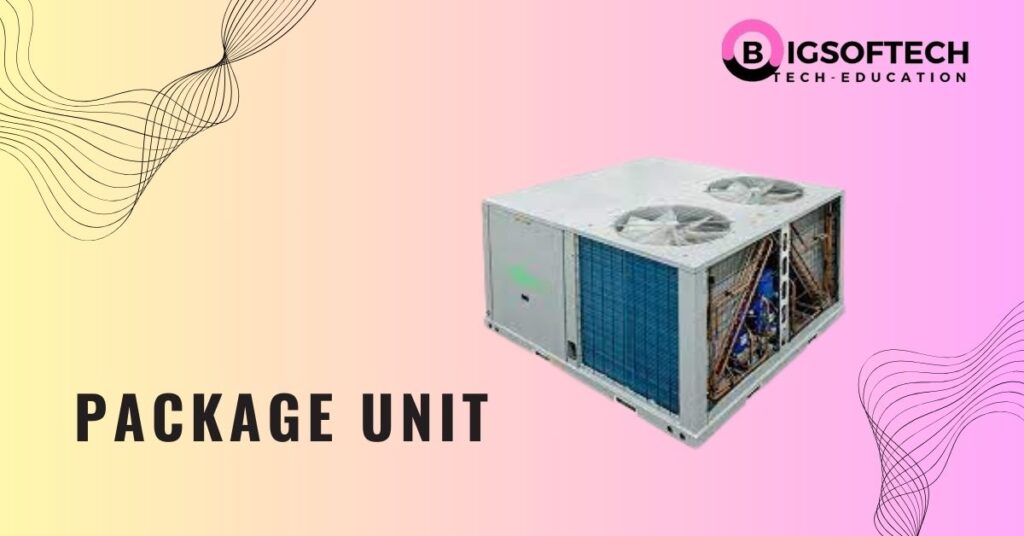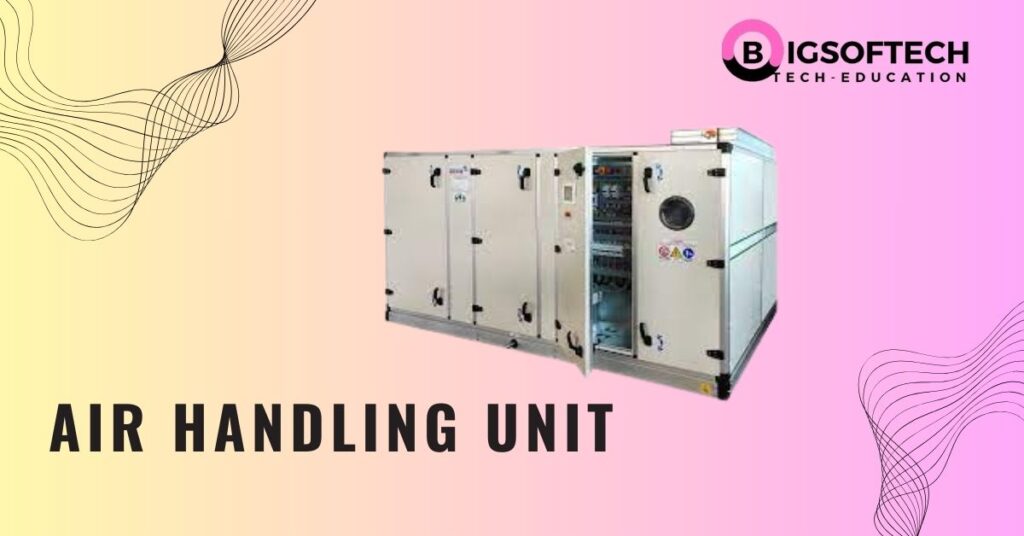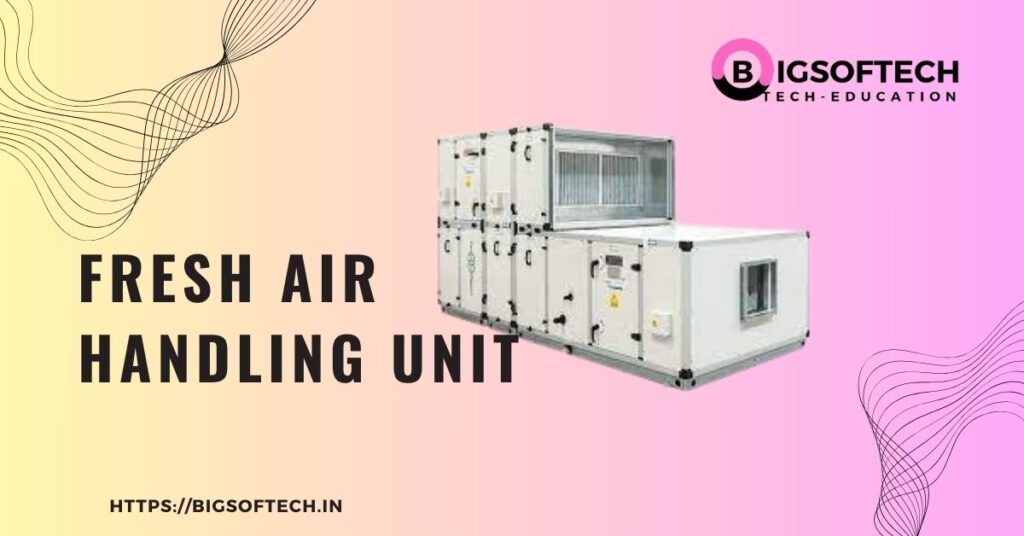HVAC (Heating, Ventilation & Air Conditioning) सिस्टम किसी भी modern building का backbone माना जाता है। इस सिस्टम का सबसे अहम हिस्सा है AHU यानी Air Handling Unit। अब सवाल आता है – What is AHU?
सीधे शब्दों में कहें तो AHU एक ऐसी machine है जो building के लिए lungs (फेफड़े) की तरह काम करती है। जैसे हमारे शरीर के lungs हवा को साफ करके oxygen पूरे शरीर तक पहुँचाते हैं, वैसे ही Air Handling Unit (AHU) हवा को filter करके, ठंडा या गर्म करके और सही तरीके से distribute करती है। इसका मुख्य काम है building के अंदर के लोगों तक fresh, clean और आरामदायक हवा पहुँचाना।
Where is AHU used?
अब जब हमने समझ लिया कि What is AHU, तो देखते हैं इसका इस्तेमाल कहाँ-कहाँ होता है। AHU का उपयोग वहाँ होता है जहाँ indoor air quality बेहद महत्वपूर्ण होती है, जैसे कि:
Hospitals – जहाँ infection control ज़रूरी होता है।
Shopping Malls – जहाँ crowd ज्यादा होता है और ventilation की need बढ़ जाती है।
IT Buildings – जहाँ centralized AC system चलता है और लगातार cooling चाहिए होती है।
Industries और Manufacturing Units – जहाँ temperature और ventilation control production के लिए जरूरी होता है।
AHU से related कुछ सवाल जो आप के मन में आ रहे होंगे चलिए जानते हैं
- AHU kya hota hai? = AHU का मतलब है Air Handling Unit, या Air Handler Unit जो हवा को साफ और control करता है।
- “AHU ka use kahan hota hai? AHU Air Handler System का इस्तेमाल Hospitals, Malls, IT Parks, Industries और Airports में किया जाता है।
- HVAC system me AHU kyu important hai? 👉 क्योंकि यह fresh Air Handling Unit की तरह काम करता है और healthy air supply कर के temperature balance करता है।


AHU क्या है? What is Air Handling Unit?
AHU का Full Form है – Air Handling Unit।
यह HVAC System सिस्टम का एक महत्वपूर्ण हिस्सा है। आसान भाषा में कहें तो AHU एक ऐसी मशीन है जो हवा को साफ (filter), ठंडा या गर्म (cool/heat) और पूरी building में distribute करती है।
👉 आप इसे building का lungs कह सकते हैं। AHU fresh air को अंदर खींचता है, उसे filter करता है ताकि dust और bacteria हट जाएँ, फिर cooling या heating coil से हवा का temperature control करता है, और blower की मदद से duct system के जरिए पूरे area में उस हवा को पहुंचाता है।
Components of AHU (Air Handling Unit)


1. Fan / Blower
Fan या Blower का काम है हवा को circulate करना और ducts के ज़रिए पूरे building तक पहुँचाना। यह AHU का सबसे visible और primary हिस्सा होता है।
Blower या Fan AHU का heart होता है। यह हवा को खींचकर ducts तक पहुँचाता है।
Types of Blower:
- Centrifugal Fan → सबसे common, static pressure handle करने के लिए।
- Plug Fan → modern AHUs में use होता है, energy efficient होता है।
Blower Size Calculation:
Blower का size CFM (Cubic Feet per Minute) पर depend करता
Example:
- 10,000 CFM AHU → blower size 18–24 inch diameter
- 20,000 CFM AHU → blower size 28–32 inch diameter
👉 इसका मतलब है कि जितनी बड़ी airflow requirement होगी, उतना बड़ा blower लगेगा।
Blower को motor से connect करने के लिए belt और pulley system use होता है।
Belt Sizes:
A-type (छोटे AHU के
- B-type (medium AHU के लिए)
- C-type (large industrial AHU के लिए)
Example:
- Small AHU (5 HP motor) → A belt
- Large AHU (15 HP motor) → B या C belt
Importance:
- Belt alignment और proper tension जरूरी है।
- Loose belt → blower slip करेगा
- Over-tight belt → bearing damage हो सकता है
2. Motor
Motor, blower को चलाने के लिए mechanical power देता है। एक efficient motor, AHU की performance और energy saving दोनों को improve करता है।
Motor blower को चलाने के लिए power provide करती है। Motor का capacity AHU की airflow और static pressure पर depend करता है।
Power Rating (kW):
Example:
- 15,000 CFM AHU → 7.5 kW motor
- 30,000 CFM AHU → 15 kW motor
3. Coil (Cooling/Heating Coil)


यह component हवा को ठंडा या गर्म करता है। AHU में coil chilled water, hot water या refrigerant gas से connected होता है, जिससे हवा का temperature control होता है। AHU की coils हवा को ठंडा या गर्म करने का काम करती हैं।
Material: Copper tubes + Aluminium fins
Coil Data:
- Rows: 4 to 8 (ज्यादा rows = ज्यादा cooling capacity)
- Fin spacing: 8–12 FPI (Fins Per Inch)
Delta T (ΔT) Calculation:
ΔT=Treturn–TsupplyΔT = T_{return} – T_{supply}ΔT=Treturn–Tsupply
Example:
Return air temp = 28°C, Supply air temp = 16°C
👉 ΔT = 28 – 16 = 12°C
- Pressure Drop (ΔP):
- Clean coil ΔP = 0.8 – 1.2 inch wg
- Dirty coil ΔP = 2.0+ inch wg
👉 अगर ΔP ज्यादा हो तो coil को clean या replace करना चाहिए।
4. Filters
Filters का main काम है हवा से dust, pollen, bacteria और अन्य impurities को remove करना। AHU में filters indoor air quality को maintain करने में सबसे महत्वपूर्ण भूमिका निभाते हैं। Filters हवा की quality maintain करते हैं। ये dust, pollen, smoke और bacteria को रोकते हैं।
Types of Filters:
- Pre-filter → Efficiency 30% (dust और बड़े particles के लिए)
- Bag filter → Efficiency 60–90% (fine dust और smoke के लिए)
- HEPA filter → Efficiency 99.97% (bacteria और virus के लिए)
👉 Hospitals और clean rooms में हमेशा HEPA filters का use किया जाता है।
5. Dampers
Dampers, fresh air और return air के ratio को control करते हैं। यह indoor comfort और ventilation balance बनाने के लिए जरूरी component है।
👉 इन सभी components का सही combination ही AHU (Air Handling Unit) को efficient और reliable बनाता है।
AHU कैसे काम करता है? (How AHU Works)


AHU (Air Handling Unit) का main काम है building के अंदर की हवा को साफ करना, उसे ठंडा या गर्म करना और फिर सही तरीके से circulate करना। चलिए step by step समझते हैं कि AHU कैसे काम करता है:
1. Air Intake
सबसे पहले fresh air बाहर से AHU के अंदर खींची जाती है। कई बार इसमें return air (building से वापस आने वाली हवा) भी mix की जाती है।
2. Filtration
Air intake के बाद हवा filters से गुजरती है। यहाँ dust, pollen, smoke और bacteria जैसी impurities remove हो जाती हैं। इससे indoor air quality improve होती है।
3. Heating / Cooling
अब हवा cooling coil या heating coil से गुजरती है।
अगर chilled water या refrigerant coil से हवा गुजरेगी तो वह ठंडी हो जाएगी।
अगर hot water या steam coil से गुजरेगी तो वह गर्म हो जाएगी।
4. Humidity Control
कुछ AHU systems में humidifier या dehumidifier लगे होते हैं जो हवा की नमी (humidity) को control करते हैं।
5. Air Circulation
इसके बाद हवा fan/blower और belt & pulley system की मदद से ducts में circulate की जाती है और building के अलग-अलग rooms तक पहुँचती है।
6. Exhaust / Return Air
AHU में dampers होते हैं जो fresh air और return air का सही ratio maintain करते हैं। साथ ही, exhaust system unclean air को बाहर निकाल देता है।
Types of AHU (Air Handling Unit)
AHU का design और काम करने का तरीका building की ज़रूरत के हिसाब से बदलता है। मुख्य रूप से AHU को इनके usage और application के आधार पर अलग-अलग categories में divide किया जाता है।
1. Draw-Through AHU
इस type में fan, coil के बाद लगा होता है। यानी हवा पहले coil से गुजरती है और फिर blower उसे ducts तक push करता है।
Advantage: हवा का distribution uniform रहता है।
Use: बड़े commercial buildings और industries में।
2. Blow-Through AHU
इसमें fan coil के पहले लगा होता है। यानी हवा पहले blower से pass होती है और फिर coil से गुजरकर ducts तक जाती है।
Advantage: compact design और कम जगह लेता है।
Use: small offices, shops और compact systems में।
3. Single Zone AHU
यह AHU केवल एक ही zone या area की हवा control करता है।
Use: Small halls, auditoriums, या classrooms।
4. Multi-Zone AHU
यह AHU एक साथ multiple zones (जैसे अलग-अलग rooms या floors) के लिए हवा supply करता है।
Use: Hospitals, malls, IT buildings जहाँ अलग-अलग temperature requirement होती है।
5. Packaged AHU
यह ready-made compact unit होती है जिसमें सारे components (fan, coil, filter, damper) एक ही box में installed रहते हैं।
Use: Hotels, restaurants, small industries।
6. Modular AHU
Modular design वाले AHU को अलग-अलग sections में design और assemble किया जाता है।
Advantage: जरूरत के हिसाब से customize किया जा सकता है।
Use: बड़े projects और industries।
7. Rooftop AHU
ये specially outdoor use के लिए design किए जाते हैं और building की छत (roof) पर install होते हैं।
Use: Shopping malls, cinema halls, airports।
Technical Data of AHU
ΔT (Delta T) – Temperature Difference in AHU
जब हम समझना चाहते हैं कि AHU कैसे काम करता है, तो एक सबसे important parameter है ΔT (Delta T)।
What is ΔT?
ΔT का मतलब होता है Temperature Difference यानी Return Air Temperature और Supply Air Temperature के बीच का अंतर।
Return Air Temperature (Treturn): वह हवा का तापमान जो कमरे (indoor space) से वापस AHU में जाती है।
Supply Air Temperature (Tsupply): वह हवा का तापमान जो AHU से filter और cool/heat होकर वापस room में भेजी जाती है।
Formula
ΔT=T1 – T2 T1 = Return T2 = Supply ΔT = Return Temp – Supply Temp
Example Calculation
- Return Air Temp = 28°C
- Supply Air Temp = 16°C
ΔT=28−16=12°CΔT = 28 – 16 = 12°CΔT=28−16=12°C
👉 इसका मतलब है कि AHU ने हवा का temperature 12°C तक कम किया।
Why is ΔT Important?
System Performance Check – अगर ΔT बहुत कम है, तो इसका मतलब है कि AHU हवा को effectively cool नहीं कर रहा।
Coil Efficiency – ΔT बताता है कि cooling coil कितना efficient काम कर रहा है।
Maintenance Indication – अगर filters dirty हों या coil fouled हो तो ΔT reduce हो जाएगा।
👉 Energy Monitoring – ΔT की सही value maintain करना energy saving और comfort दोनों के लिए जरूरी है।
ΔP (Delta P) – Pressure Drop
- Definition: Filter, coil या duct से गुजरते समय हवा में होने वाला pressure difference।
- Measurement Tool: U-tube Manometer / Digital Manometer
- Example (Filter):
- Clean Filter ΔP = 1 inch wg
- Dirty Filter ΔP = 2 inch wg
👉 अगर ΔP ज्यादा बढ़ जाए तो filter jam है और उसे clean/replace करना होगा।
AHU Maintenance Checklist
Preventive Maintenance (Regular & Scheduled)
ये activities routine में की जाती हैं ताकि AHU smoothly चले।
Daily / Weekly Checks
Filters की condition check करें और आवश्यकता पड़ने पर साफ/replace करें।
Supply और return air temperature record करें (ΔT verify करने के लिए)।
Blower/fan की sound और vibration observe करें।
Dampers की operation check करें (smoothly open/close हो रहे हैं या नहीं)।
Drain pan और drain line साफ रखें (water clogging न हो)।
Monthly Checks
Belt & Pulley tension और alignment inspect करें।
Motor की current/voltage readings check करें।
Cooling/heating coil fins inspect करें और dirt होने पर coil cleaning करें।
Electrical connections tighten करें।
Humidifier (अगर है) inspect और clean करें।
Quarterly / Half-Yearly Checks
Airflow (CFM) measure करें और design values से compare करें।
Bearings lubrication करें।
Vibration analysis basic check करें।
Fresh air intake louvers साफ करें।
Complete AHU casing की leakage check करें।
Predictive Maintenance (Condition-Based)
यह advanced monitoring है जो AHU की actual condition predict करती है ताकि future breakdown रोके जा सकें।
- Vibration Analysis → Motor और blower shaft imbalance detect करने के लिए।
- Infrared Thermography → Electrical connections और motor winding overheating check करने के लिए।
- Oil Analysis (अगर gear box या special lubrication है)।
- Filter Pressure Drop Monitoring → Sensors से पता चलेगा कि filters clogged हैं या नहीं।
- Energy Consumption Monitoring → अगर ΔT कम हो रहा है और power consumption बढ़ रही है तो coil fouling या refrigerant problem हो सकती है।
- IoT/Smart Sensors → Temperature, humidity, airflow और vibration data continuously monitor करने के लिए।
👉 Benefits of Proper AHU Maintenance
- Indoor Air Quality (IAQ) better होती है।
- Energy saving होता है।
- Equipment की life increase होती है।
- Unexpected breakdowns कम होते हैं।
- Occupants को comfort मिलता है।
Conclusion
अब तक आपने समझा कि What is AHU (Air Handling Unit) और यह HVAC system का कितना महत्वपूर्ण हिस्सा है। सरल शब्दों में कहें तो AHU एक ऐसा device है जो building के लिए lungs की तरह काम करता है – यह हवा को filter करता है, उसे ठंडा या गर्म करता है और सही तरीके से circulate करके लोगों तक साफ और आरामदायक हवा पहुँचाता है।
चाहे hospital हो, shopping mall, IT building या industry – AHU के बिना indoor air quality और comfort maintain करना संभव नहीं है। इसके अलग-अलग types, components और working principle मिलकर इसे efficient बनाते हैं।
👉 इसलिए, अगर आप अपनी building में बेहतर air quality, energy saving और occupants के comfort को सुनिश्चित करना चाहते हैं, तो AHU का सही design, installation और regular maintenance बेहद जरूरी है।




